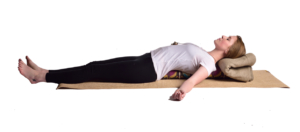 One of the first bolster-type pillows that Hugger Mugger made back in the 1980s was the pranayama bolster. Made to BKS Iyengar’s specifications, the pillow is designed to support the spine and expand the chest for free respiration in supine pranayama practice.
One of the first bolster-type pillows that Hugger Mugger made back in the 1980s was the pranayama bolster. Made to BKS Iyengar’s specifications, the pillow is designed to support the spine and expand the chest for free respiration in supine pranayama practice.
Until the 20th century, pranayama was always practiced in a sitting position. BKS Iyengar discovered that not all his students could sustain this position easily for long periods of time.
Using props, he designed a way for practitioners to practice lying down instead. This allowed students of all body types to practice pranayama with a neutral spine. Placing a pranayama pillow under the spine from the lumbar to the head, and a blanket supporting the head and neck (see the above photo), a practitioner can enjoy an expanded chest and lengthened spine. The blanket supporting the head promotes a gentle form of jalandhara bandha (chin lock) to keep the prana from rushing up into the head and possibly causing a headache.
Lying down pranayama is appropriate for anyone—beginners and experienced practitioners. It’s especially welcome when you come to practice in a state of fatigue. Not having to hold your body up allows you to concentrate solely on the breath.
Other Ways to Enjoy Your Pranayama Pillow
Savasana: Sometimes we need just a little bit of support under our knees for a comfortable Savasana. Pranayama pillows are much narrower than Standard, Round or Junior bolsters. While all three of these bolster types can be appropriate as Savasana props, Pranayama Pillows, placed crosswise under the knees, are great for people who need just a little extra support.
Passive back bending: Because of their narrow width and shorter height, pranayama pillows are comfortable for just about anyone in passive back bending. Placed crosswise under the lumbar-thoracic spine while you’re in a supine position, a pranayama pillow can create a relaxing lumbar support to ease tension buildup from our mostly forward-bent lives.
For more information on ways to incorporate pranayama practice into your life, read this post.
